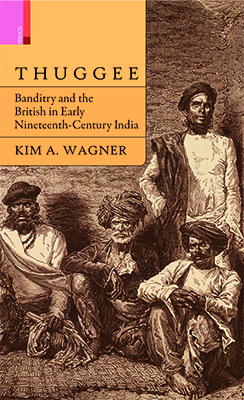
INFORMATION
- AUTHOR : Kim A. Wagner
- HB ISBN : 978-93-80607-76-4
- Year : 2014
- Extent : 288 pp.
- For sale only in South Asia
- Discount available on checkout
- Usually dispatched within 3 to 5 working days.
Tagore
| HB ₹ 995 . $ . ₤ |
PB ₹ . $ . ₤ |
|
| POD ₹ . $ . ₤ |
e-Book ₹ . $ . ₤ |
INFORMATION
- AUTHOR –
- ISBN – 978-93-84082-78-9
- Year – 2016
- Extent: 400 + 40 coloured illustrations
- 10% discount + free shipping
- Usually dispatched within 3 to 5 working days.
This book constitutes the first in-depth examination of thuggee as a type of banditry which emerged in a specific socio-economic and geographic context. Thuggee did not constitute a caste-like identity, and was a means of obtaining a livelihood reverted to by all strata of Indian society in certain areas. As such it constituted a highly institutionalized social practice related to issues of patronage and retainership, identity and legitimacy, and was defined by the appropriation of high status rituals and martial ethos. The history of ‘thugs’ need no longer be limited to the study of their representations, and this book reconstructs and historicizes thuggee as a social phenomenon—as less than the sacrificial cult constructed by the British, yet more than the colonial phantasmagoria counter-posited by post-colonial scholars.
The Author
Kim A. Wagner is Senior Lecturer in British Imperial History at Queen Mary, University of London, UK. He works on imperialism, conflict and culture, and has published extensively on banditry and rebellion in colonial India, especially on the subject of ‘Thuggeee’ and the Indian Uprising of 1857. He is the author of Stranglers and Bandits—A Historical Anthology of Thuggee (2009) and co-editor of Engaging Colonial Knowledge: Reading European Archives in World History (2011). He is particularly interested in British fears of indigenous conspiracies and his research focusses on colonial policing and intelligence gathering as well as the correlation between knowledge, panic and anxieties within the context of empire.
As a global figure, Tagore transcends the boundaries of language and reaches out to people distant both in time and space. His art took inspiration from contemporary Western trends and became a powerful means to connect with people beyond Bengal. Word, image, song, and text were his tools of communication, as also his extraordinary presence in a sartorial garb of his own design. A littérateur in many genres, the impact of his work was determined both by the material he presented, and by its simultaneously local and global contexts. Now, when his international reputation has spanned over more than a hundred years, it is important to revisit the sites of Tagore’s eminence, and ask to what extent he was a ‘living text’ in the century that witnessed him as a global intellectual.
Accordingly, this volume investigates how Tagore’s writings and art are linked to the metalinguistic domains of the psychological, medical and mythical; how he was received in various cultures outside India; how his art was determined by individual circumstances and global aspirations; and how he acted as an inspiration to his contemporaries and subsequent generations including modern Indian writers and artists.
The Editor
Imre Bangha studied in Budapest and Santiniketan and at present is Associate Professor of Hindi at the University of Oxford. He has published books and essays in English, Hindi, and Hungarian on literature in Brajbhasha and other forms of old Hindi and has also prepared Hungarian translations from various South Asian languages. His work on the international reception of Bengali culture includes Rabindranath Tagore: Hundred Years of Global Reception (2014, co-edited with M. Kämpchen) and Hungry Tiger: Encounter between India and Central Europe (2007).
Table of Contents
| List of Maps and Illustrations | xi-xii |
| Preface to the South Asian Edition | xiii |
| Preface | xv-xvii |
| Acknowledgements | xix |
| List of Abbreviations | xxi-xxii |
| Abbreviated Sources | xxiii-xxiv |
| Glossary | xxv-xxvi |
| Introduction | 1-14 |
| Part I | |
| 1. Engaging the Colonial ‘Archives of Repression’ | 17-26 |
| 2. Thuggee in Pre-Colonial India | 27-34 |
| 3. The Discovery of Thuggee, Etawah 1809 | 35-52 |
| 4. Thomas Perry and the First Arrests | 53-68 |
| 5. N . J. Halhed in Sindouse, October 1812 | 69-80 |
| Part II | |
| 6. Sindouse | 83-103 |
| 7. The Practice of Thuggee | 104-125 |
| 8. The Itinerant Underworld | 126-140 |
| 9. The World of the Thugs | 141-171 |
| Part III | |
| 10. H alhed in Sindouse—A Second Look | 175-183 |
| 11. S indouse—The Aftermath | 184-193 |
| 12. Continued Measures Against Thugs | 194-208 |
| 13. The Operations Commence | 209-221 |
| 14. The Thuggee Campaign | 222-230 |
| 15. FromSindouse to Sagar | 231-239 |
| Epilogue | 241-246 |
| Select Bibliography | 247-255 |
| Index | 257-261 |




